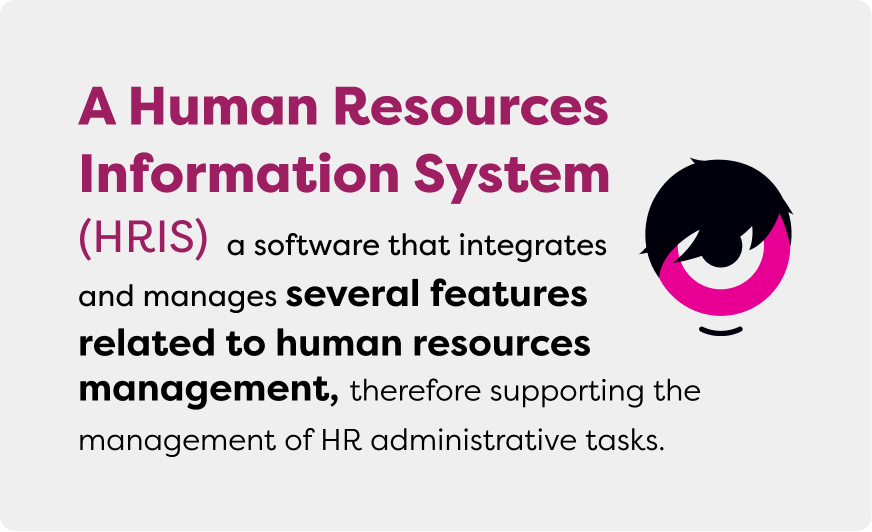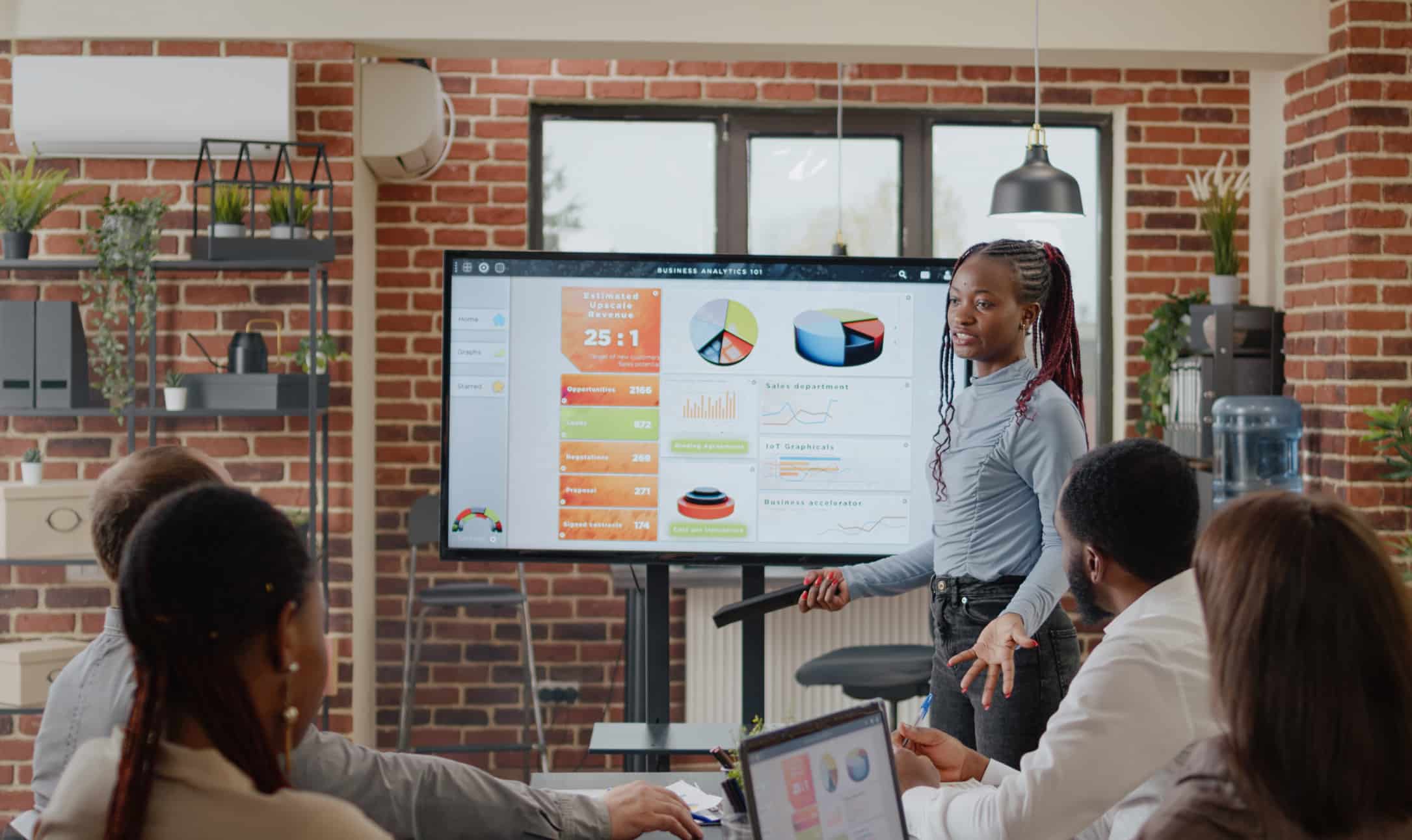In recent years, Human Resources Information Systems (HRIS) have been at the forefront of HR discussions and are taking on an increasingly important role in companies’ human resources management. But more concretely, what is an HRIS ? What are its key features, and above all, how can it help you reach your organizational goals and improve your current HR processes? Here is everything you need to know, including pros and cons to be aware of and tips for choosing the best HRIS for your business.
Definition and Role of HRIS
A Human Resources Information System (HRIS) is a software that integrates and manages core HR features such as administrative employee records, supporting the management of administrative tasks and critical HR processes.
HRIS tools automate manual processes and offer a clear and global vision of organizational effectiveness in business strategy and employee productivity and engagement.

To understand what an HRIS entails, why not ask the people who use it every day?
According to Tracey Beveridge, HR Director at Personnel Checks, here is a comprehensive definition:
“I would define HRIS as a centralized system for managing all core HR functions. A good HRIS should streamline key HR processes, save managers and employee time and reduce risk of errors.
It should also directly benefit employees, creating a more seamless experience for them right from hiring and onboarding, throughout their employment and then offboarding. I would expect a modern system also to provide detailed analytics to allow us to easily produce reports and answer any exec team queries.
Our HRIS is absolutely essential to the running of our business. It deals with all of the above, but it also has additional functions to help with the business’s day-to-day running. For example, it contains a knowledge base of training and checklists to assist staff in completing their roles correctly. This is especially valuable as many of the team work away from the office, and it allows management to easily track progress and make sure work is being carried out appropriately. For any business that does not yet have a central HRIS, I would strongly recommend they implement one as soon as possible. There is a wide variety of options available on the market with something to suit all sizes of business, and the amount of time saved and the benefits of having everything all in one place is invaluable and well worth the investment.”
According to Gary Warner, Marketing Manager at Joloda Hydraroll, here is the essential role of an HRIS:
“HRIS is, effectively, a single source of the truth for all things related to employees. The alternative is several systems for payroll, recruitment, training, benefits, performance management, etc. Having several systems means that manual updates are usually needed across all systems, which can lead to mistakes and omissions.
A good HRIS system saves time, increases accuracy, and provides HR reporting and analytics that are not available when independent systems are used. This means hiring trends can be linked to retention, and training can be linked to performance. Insights such as these can be extremely valuable for any organization and help to inform future strategies.
Another bonus of a good HRIS system is the employee portal. This allows employees to download their payslips and amend their benefits. This not only gives the employee increased flexibility but also saves the HR and associated teams considerable time.”
Different Types of HR Software Solutions
HRIS vs. HRMS vs. HCM
The differences are subtle! Here are short explanations:
As we have seen, HRIS is data-driven and provides insights. Employee records and profiles represent these systems’ core and cover almost every aspect of HR management and of the employee lifecycle.
The name Human Resource Management System was more frequently used to refer to on-premises systems (not on the cloud). Nowadays, most HRMS are cloud-based, and they are often associated with bigger companies that need additional features.
Human Capital Management focuses on talent acquisition, talent management and talent organization to improve employee experience.
Key Features of HRIS
HRIS offers a wide range of features and covers many administrative tasks for human resources management, from onboarding to performance reviews and PTO management.
1. HR Dashboard
Interactive HR dashboards give a global vision of the tasks left to be done (PTO approval, for instance) as well as possible incidents or anomalies related to employees. These indicators are all found in one place to provide you with valuable insights. It is then possible to dig deeper into different categories of performance metrics by accessing the corresponding tabs.
You simply need to use Key Performance Indicators in your day-to-day processes : HR analytics are a must for organizations that want to stay on top of their game.
2. Employee Database
Employee profiles database contain all the information needed for quick navigation (department, positions, supervisor, any note to the file, etc.). As for workers, they have access to their personal information and can quickly update it through the employee self-service portal if needed.
Employee data privacy is also assured, and you can even set up dematerialized contract management with electronic signatures.
They can also check their time bank at any moment and request vacation time accordingly or simply complete their daily timesheet.
3. Employee Performance Review
Some HR systems also offer performance management features that allow to track individual progress and goal achievements. This allows managers from each department to identify potential issues related to employees and solve them accordingly.
Some HRIS systems offer performance review features that can be customized according to the methods used in your organization, be it 360-degree appraisal or self-assessments.
4. Employee Onboarding
New hire onboarding is time-consuming and requires completing a lot of administrative steps. HRIS takes care of the administrative aspect of onboarding by automating reminders addressed to the people in charge and by building personalized onboarding plans.
The Main Benefits of HRIS
HRIS have many advantages to offer your company, your HR department and your employees. Here are some of the main benefits of implementing this solution in your company:
Saving time on HR management processes
HRIS reduces the burden of time-consuming tasks, leaving you more time to devote to projects with real added value and to the strategic side of your role. Indeed, automating administrative management saves considerable time for both managers and employees. Whether for onboarding, performance management or training, you’ll save time on all the essential stages of the employee experience.
More efficient talent management
By automating reminders of tasks to be completed, certifications to be renewed, and making employee information available in just a few clicks, HRIS helps you adopt the best practices you need in your day-to-day HR management.
This automation of administrative tasks enables the HR department to focus on what really matters: employee well-being and the creation of a healthy, engaging work environment for all. Moreover, employee self-service makes it easier for them to manage their working hours and request time off.
Centralized employee management and HR data
One of the main aims of HRIS software is to provide complete access to and centralization of human resources management information so that you don’t have to waste time collecting and accessing it on a daily basis. If you previously had to multiply clicks and processes to access your payroll software, your Excel-based employee files, and your intranet, you now get all this information and integration centralized on a single platform.
Greater strategic visibility
Access to a centralized database updated over time, as well as to various HR performance indicators, enables better data management and greater visibility of your organizational health. A human resources information system can therefore support strategic initiatives, for example, by guiding your action plans to reduce costly turnover rates for your organization.
Increased employee engagement and productivity
Did you know that automating onboarding tasks with HR software can increase the new hire retention rates by 16%? This statistic is just one example of the positive impact that HR software can have on your organization: increased employee motivation as a result of less red tape, a better employee experience from the very first days at the company, and your teams’ focus on stimulating value-added tasks… A good HRIS will also enable you to make decisions that benefit the entire workforce, reducing turnover rates.
Click here to learn more about the potential return on investment of HR software!
The Potential Disadvantages of HRIS
Despite the many advantages detailed above, it can sometimes be difficult to find the best HRIS for your company’s reality. Before making your choice, it’s essential to be aware of the disadvantages that may exist so you can make an informed decision.
Implementation costs and timescales
Some software solutions are expensive and exceed the budget limits you should set at the outset of your implementation project. Very often, these platforms offer additional functionalities that are not essential to your business reality and can be costly. Don’t hesitate to see if other purchase plans are available or to turn to other solution providers. Similarly, ensuring that implementation timescales are realistic and adapted to your needs is essential.
Lack of integration with other solutions
To choose the best HR software for your organization, you need to ensure that it integrates with your existing digital ecosystem or with other solutions you wish to implement in the future. For example, it’s important to opt for HR software that integrates with payroll solutions or benefits platforms. These integration possibilities help you avoid multiple accesses and clicks, as well as data fragmentation, and make your day-to-day work easier.
Lack of flexibility and adaptability to your reality
A good HRIS must be easy to use, but also adapted to your sector of activity, your organizational reality and your geographical location. It’s often easier to implement software developed with your country’s regulations in mind. If it takes into account the needs of your organizational sector and is user-friendly for all your employees, it’s undeniably a big plus for your company!
Choosing and Integrating the Right HRIS for Your Organization
Before integrating an HRIS into your organization, it’s crucial to take into account a number of essential selection criteria and follow the steps below:
1. Create a requirements checklist
First of all, it’s important to analyze your needs and organizational reality to determine what your selection criteria are, and what features and aspects are most important to your business.
What are your priorities, and which features will help you improve your working environment and achieve your strategic objectives? Is the software solution available in your language and adapted to your country’s regulations? Does it fit in well with your existing digital ecosystem? Does the support service meet your expectations?
By asking yourself the right questions, you’ll be able to create a checklist of HR software requirements and ensure that the software presented is adapted to your needs and reality.
2. Evaluate your budget and time
It’s also essential to assess the budget you wish to devote to your HR solution and compare it with the costs offered on the market. Similarly, you need to give the person in charge the time to research and compare software, as well as schedule meetings and participate in the implementation of the platform in your organization. Depending on your situation and the solution you choose, HRIS implementation may also require time for adaptation and training, which should be taken into account right from the start of your integration project.
3. Pay particular attention to security and regulations
In addition to being adapted to your organizational reality, the HRIS you are looking for must be reliable and consolidate your digital ecosystem by meeting essential confidentiality and security criteria, such as SOC 2 certification. What’s more, the software solution must comply with the regulations in force in your country and be available in the language(s) your employees use on a daily basis. Of course, it’s also a good idea for support services to be available in your own language to facilitate the smooth integration of the platform into your organization.
4. Request a demonstration
You can – and should – discover the main features and advantages of HRIS during a detailed demonstration that covers your expectations and requirements. During this meeting, don’t hesitate to ask questions and evaluate the human contact you manage to create with the representative(s) present.
It’s important to assess the relationship you can build with the company developing the software, in particular by asking questions about the support service offered and the help you’ll receive during the implementation phase, as well as during day-to-day use of the platform.
Offering undeniable benefits to reach business goals, Human Resources Information Systems represent the future of workforce management. Less rigid and more empowering, in addition to being true drivers of organizational progress, HR cloud-based technology is definitely bound to last.
Folks HR offers flexible and easy-to-implement HR software that will optimize your human resource functions while saving you considerable time daily. Discover our numerous core HR features!
Want to learn more about Folks HR?
Discover Human Resources professionals' favorite HRIS!
REQUEST YOUR FREE DEMO










